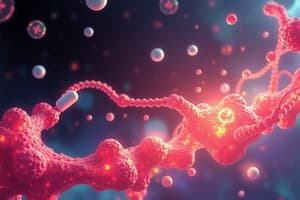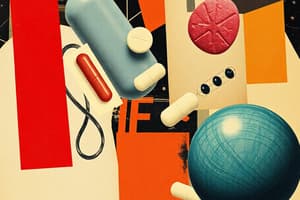Podcast
Questions and Answers
What is the primary goal of drug therapy?
What is the primary goal of drug therapy?
- To use the most potent drug available
- To provide maximum benefit with minimal harm (correct)
- To eliminate all disease without adverse reactions
- To achieve a cure irrespective of side effects
Which property is considered the most important for an ideal drug?
Which property is considered the most important for an ideal drug?
- Safety
- Selectivity
- Reversible action
- Effectiveness (correct)
Why is the concept of 'no safe drugs' important in pharmacology?
Why is the concept of 'no safe drugs' important in pharmacology?
- Because safety is secondary to effectiveness
- Because all drugs have the potential to cause harm (correct)
- Because drugs are never 100% effective
- Because patients generally misuse drugs
Which of the following is considered an 'other' property, rather than part of the 'Big 3', of the ideal drug?
Which of the following is considered an 'other' property, rather than part of the 'Big 3', of the ideal drug?
What does the term 'pharmacology' fundamentally involve?
What does the term 'pharmacology' fundamentally involve?
According to the provided information, which of the following is classified as a Schedule I controlled substance?
According to the provided information, which of the following is classified as a Schedule I controlled substance?
A medication with the suffix '-statin' is most likely used to treat which of the following?
A medication with the suffix '-statin' is most likely used to treat which of the following?
Approximately what percentage of medication doses administered in the United States are from over-the-counter (OTC) drugs?
Approximately what percentage of medication doses administered in the United States are from over-the-counter (OTC) drugs?
Which of the following best describes a Schedule III drug?
Which of the following best describes a Schedule III drug?
Which of the following best describes the action of p-glycoprotein?
Which of the following best describes the action of p-glycoprotein?
According to the content, what is the primary mechanism by which most drugs cross cell membranes?
According to the content, what is the primary mechanism by which most drugs cross cell membranes?
What is a key factor in determining how quickly a drug will have an effect?
What is a key factor in determining how quickly a drug will have an effect?
If a drug is described as 'lipophilic', what does this indicate about its properties?
If a drug is described as 'lipophilic', what does this indicate about its properties?
Which of the following correctly describes the term 'pharmacokinetics'?
Which of the following correctly describes the term 'pharmacokinetics'?
What is the role of the liver in the context of pharmacokinetics?
What is the role of the liver in the context of pharmacokinetics?
What is the function of the kidney in pharmacokinetics?
What is the function of the kidney in pharmacokinetics?
If a drug is given intravenously (IV), what does this administration route bypass?
If a drug is given intravenously (IV), what does this administration route bypass?
Which of the following best describes the meaning of 'pH partitioning' in drug absorption?
Which of the following best describes the meaning of 'pH partitioning' in drug absorption?
How does increased blood flow at the site of administration affect drug absorption?
How does increased blood flow at the site of administration affect drug absorption?
A patient is taking a medication with the suffix '-prazole', what is it most likely prescribed for?
A patient is taking a medication with the suffix '-prazole', what is it most likely prescribed for?
Which type of drug reaction is primarily determined by the degree of immune system sensitization, rather than the dosage of the drug?
Which type of drug reaction is primarily determined by the degree of immune system sensitization, rather than the dosage of the drug?
A patient experiences an uncommon drug response due to a genetic predisposition. This is best described as which type of reaction?
A patient experiences an uncommon drug response due to a genetic predisposition. This is best described as which type of reaction?
A patient abruptly stops taking a medication and experiences withdrawal symptoms. Which term best describes this scenario?
A patient abruptly stops taking a medication and experiences withdrawal symptoms. Which term best describes this scenario?
A drug-induced disease that mimics a naturally occurring pathology is known as what type of disease?
A drug-induced disease that mimics a naturally occurring pathology is known as what type of disease?
When two drugs with similar actions are combined, and their effects are additive, what kind of drug-drug interaction is this?
When two drugs with similar actions are combined, and their effects are additive, what kind of drug-drug interaction is this?
If the combination of two drugs results in a greater effect than the sum of their individual effects, this is an example of:
If the combination of two drugs results in a greater effect than the sum of their individual effects, this is an example of:
If one drug reduces the effect of another drug, this interaction is best described as:
If one drug reduces the effect of another drug, this interaction is best described as:
What term describes what the body does to a drug?
What term describes what the body does to a drug?
What term describes what the drug does to the body?
What term describes what the drug does to the body?
In which phase of drug development is the drug first released for general use, allowing for observations in a large population?
In which phase of drug development is the drug first released for general use, allowing for observations in a large population?
During which stages of new drug development are the therapeutic effects, dosage range, safety and effectiveness determined?
During which stages of new drug development are the therapeutic effects, dosage range, safety and effectiveness determined?
The official name of a drug used on national board exams is known as the:
The official name of a drug used on national board exams is known as the:
A drug is classified by its mechanism of action (MOA). This is best described as the:
A drug is classified by its mechanism of action (MOA). This is best described as the:
Drugs used to treat high blood pressure are grouped under which therapeutic classification?
Drugs used to treat high blood pressure are grouped under which therapeutic classification?
A drug that is classified as a selective serotonin reuptake inhibitor (SSRI) belongs to which drug classification?
A drug that is classified as a selective serotonin reuptake inhibitor (SSRI) belongs to which drug classification?
A drug administered via which route will bypass the first-pass effect?
A drug administered via which route will bypass the first-pass effect?
Which of the following factors primarily affects the rate at which a drug is transported from the blood to the tissues?
Which of the following factors primarily affects the rate at which a drug is transported from the blood to the tissues?
Why is the blood-brain barrier significant in pharmacology?
Why is the blood-brain barrier significant in pharmacology?
What is the primary consequence of non-ionized drugs becoming ionized in the fetal compartment?
What is the primary consequence of non-ionized drugs becoming ionized in the fetal compartment?
Why are drugs bound to plasma proteins like albumin considered inactive?
Why are drugs bound to plasma proteins like albumin considered inactive?
What is the potential consequence of liver enzyme induction on drug metabolism?
What is the potential consequence of liver enzyme induction on drug metabolism?
Why are infants at particular risk for adverse drug effects related to metabolism?
Why are infants at particular risk for adverse drug effects related to metabolism?
What is the first-pass effect?
What is the first-pass effect?
How does decreased gastric acidity in the elderly affect drug absorption?
How does decreased gastric acidity in the elderly affect drug absorption?
What is the effect of reduced blood flow to the GI tract in the elderly on the first-pass effect?
What is the effect of reduced blood flow to the GI tract in the elderly on the first-pass effect?
What makes the capillaries in the brain unique in comparison to standard capillaries found elsewhere?
What makes the capillaries in the brain unique in comparison to standard capillaries found elsewhere?
Why are poorly perfused areas like abscesses and solid tumors a challenge for drug therapy?
Why are poorly perfused areas like abscesses and solid tumors a challenge for drug therapy?
What factor influences a drug's ability to cross the placenta?
What factor influences a drug's ability to cross the placenta?
What is the importance of the dynamic equilibrium between bound and unbound drug molecules?
What is the importance of the dynamic equilibrium between bound and unbound drug molecules?
What is the main consequence of competition between two drugs metabolized by the same system?
What is the main consequence of competition between two drugs metabolized by the same system?
Flashcards
Pharmacology
Pharmacology
The study of drugs and their interactions with living organisms.
Therapeutics
Therapeutics
The use of drugs to diagnose, prevent, or treat disease, or to prevent pregnancy.
Drug
Drug
A chemical that can affect living processes.
Effectiveness
Effectiveness
Signup and view all the flashcards
Selectivity
Selectivity
Signup and view all the flashcards
Idiosyncratic Effect
Idiosyncratic Effect
Signup and view all the flashcards
Physical Dependence
Physical Dependence
Signup and view all the flashcards
Iatrogenic Disease
Iatrogenic Disease
Signup and view all the flashcards
Drug Interaction: Addition
Drug Interaction: Addition
Signup and view all the flashcards
Drug Interaction: Synergism
Drug Interaction: Synergism
Signup and view all the flashcards
Drug Interaction: Inhibition
Drug Interaction: Inhibition
Signup and view all the flashcards
Pharmacokinetics
Pharmacokinetics
Signup and view all the flashcards
Pharmacodynamics
Pharmacodynamics
Signup and view all the flashcards
Drug Elimination
Drug Elimination
Signup and view all the flashcards
Drug Half-Life
Drug Half-Life
Signup and view all the flashcards
Minimum Effective Concentration (MEC)
Minimum Effective Concentration (MEC)
Signup and view all the flashcards
Maximum Safe Concentration (MSC)
Maximum Safe Concentration (MSC)
Signup and view all the flashcards
Therapeutic Range
Therapeutic Range
Signup and view all the flashcards
Dosage
Dosage
Signup and view all the flashcards
Time to Peak
Time to Peak
Signup and view all the flashcards
What type of drug classification has high abuse potential but no accepted medical use?
What type of drug classification has high abuse potential but no accepted medical use?
Signup and view all the flashcards
What type of drug classification has high abuse potential but is used for treatment?
What type of drug classification has high abuse potential but is used for treatment?
Signup and view all the flashcards
What is pharmacokinetics?
What is pharmacokinetics?
Signup and view all the flashcards
Define absorption in relation to pharmacokinetics.
Define absorption in relation to pharmacokinetics.
Signup and view all the flashcards
Define distribution in pharmacokinetics.
Define distribution in pharmacokinetics.
Signup and view all the flashcards
Define metabolism in pharmacokinetics.
Define metabolism in pharmacokinetics.
Signup and view all the flashcards
Define excretion in pharmacokinetics.
Define excretion in pharmacokinetics.
Signup and view all the flashcards
How does the rate of absorption affect the drug's effects?
How does the rate of absorption affect the drug's effects?
Signup and view all the flashcards
How does the amount of absorption affect the drug's effects?
How does the amount of absorption affect the drug's effects?
Signup and view all the flashcards
How does the route of administration affect absorption?
How does the route of administration affect absorption?
Signup and view all the flashcards
How does lipid solubility affect absorption?
How does lipid solubility affect absorption?
Signup and view all the flashcards
What is P-glycoprotein and how does it affect drug distribution?
What is P-glycoprotein and how does it affect drug distribution?
Signup and view all the flashcards
What is the rate of dissolution and how does it affect drug absorption?
What is the rate of dissolution and how does it affect drug absorption?
Signup and view all the flashcards
How does surface area affect drug absorption?
How does surface area affect drug absorption?
Signup and view all the flashcards
How does blood flow affect drug absorption?
How does blood flow affect drug absorption?
Signup and view all the flashcards
Sublingual administration
Sublingual administration
Signup and view all the flashcards
Drug absorption
Drug absorption
Signup and view all the flashcards
Intravenous (IV) administration
Intravenous (IV) administration
Signup and view all the flashcards
Drug distribution
Drug distribution
Signup and view all the flashcards
Blood-brain barrier
Blood-brain barrier
Signup and view all the flashcards
Plasma protein binding
Plasma protein binding
Signup and view all the flashcards
Drug metabolism
Drug metabolism
Signup and view all the flashcards
First-pass effect
First-pass effect
Signup and view all the flashcards
Blood flow to tissues
Blood flow to tissues
Signup and view all the flashcards
Drug excretion
Drug excretion
Signup and view all the flashcards
Drug induction or inhibition
Drug induction or inhibition
Signup and view all the flashcards
Drug absorption in the elderly
Drug absorption in the elderly
Signup and view all the flashcards
Drug metabolism in the elderly
Drug metabolism in the elderly
Signup and view all the flashcards
Drug excretion in the elderly
Drug excretion in the elderly
Signup and view all the flashcards
Bound drug
Bound drug
Signup and view all the flashcards
Study Notes
Pharmacology Basics
- Drug: Any chemical affecting living processes.
- Pharmacology: Study of drugs and their interactions.
- Clinical Pharmacology: Study of drugs in humans.
- Therapeutics (Pharmacotherapeutics): Medical use of drugs to diagnose, prevent, or treat disease, including contraception.
- Therapeutic Objective: Maximum benefit, minimum harm. Requires skill, judgment, knowledge, and a commitment to minimizing harm. Study, learn, and apply are critical.
Properties of an Ideal Drug
- Effectiveness: The most crucial property.
- Safety: No drug is completely safe; all have side effects.
- Selectivity: No drug is completely selective; all have side effects.
Other Ideal Drug Properties
- Reversible Action: Effects cease when the drug is discontinued.
- Predictability: The drug's effects are consistent and known.
- Ease of Administration: Convenient and simple method of intake.
- Freedom from Drug Interactions: No interference with other drugs' effects.
- Low Cost: Affordable for patients.
- Chemical Stability: Maintains its intended action over time.
- Simple Generic Names: Clear and unambiguous identifying names.
Adverse Drug Reactions
-
Allergic Reactions: Immune response (Type I and IV Hypersensitivity). Determined by immune system sensitization, not dosage. Patient sensitivity can change over time. Few drugs cause severe allergic reactions. Penicillins are common culprits; others include sulfonamides, diuretics, antibiotics, and oral hypoglycemics.
-
Idiosyncratic Effect: Uncommon response due to genetic predisposition. Example: Succinylcholine-induced paralysis (acetylcholinesterase deficiency).
-
Paradoxical Effect: Opposite of intended response. Benzodiazepines for insomnia may cause excitement, especially in children and the elderly.
-
Physical Dependence: Body adapts to chronic drug use, leading to withdrawal symptoms (opioids, alcohol, barbiturates, amphetamines). Abrupt discontinuation is dangerous, requiring professional guidance.
-
Iatrogenic Disease: Disease caused by medical treatment (e.g., antipsychotic meds causing Parkinson's symptoms).
Drug-Drug Interactions
- Addition (Potentiation): Similar drugs have additive effects (1 + 1 = 2). Example: diuretic plus beta-blocker.
- Synergism: Different drugs enhance each other's effects (1 + 1 > 2). Example: Bactrim (two antibiotics combined).
- Inhibition: One drug reduces the effects of another (1 + 1 < 2). Example: Morphine plus naloxone.
Drug-Drug Interactions (Kinetics)
- Intensification of Effects/Increased Therapeutic/Adverse Effects: Example: Sulbactam and ampicillin (increased therapeutic). Aspirin and warfarin (increased adverse).
- Reduction of Effects/Inhibitory/Reduced Therapeutic/Adverse Effects: Example: Propranolol and albuterol (reduced therapeutic). Naloxone for morphine overdose (reduced adverse).
Factors Determining Drug Response Intensity
- Administration Method
- Pharmacokinetics: What the body does to the drug (absorption, distribution, metabolism, excretion).
- Pharmacodynamics: What the drug does to the body.
- Individual Variation: Responses vary from person to person.
New Drug Development
- Phase I: Evaluates drug metabolism, pharmacokinetics, and biologic effects.
- Phase II and III: Determines therapeutic effects, dosage range, safety, and effectiveness.
- Phase IV: New drug released for general use, allowing observation in a large population.
Exercise Discretion Regarding New Drugs
- Balance potential benefits against inherent risks.
- New drugs generally present more risks initially. Consider pharmaceutical representatives' incentives.
- Exercise caution and due diligence with new medications.
Drug Naming
- Chemical Formula: Complex chemical description. Example: 3,3-Dimethyl-7-oxo-6-(2-phenoxyacetamido)-4-thia-1-azabicyclo[3.2.0]heptane-2- carboxylic acid.
- Chemical Name: More specific and descriptive; Example: Phenoxymethylpenicillin.
- Generic Name: Official name; example penicillin V. (Used on national board exams).
- Trade Name: Commercial name; Example: Propicillin®.
Generic vs. Trade Names
- Generic Names: More complicated, can be easily confusing.
- Trade Names: Multiple trade names for one drug are common. Examples: Adalat CC®, Nifedical XL®, Nifediac CC®, Procardia®, Procardia XL® are all nifedipine (a calcium channel blocker).
- United States drugs and drugs outside the United States may have different active ingredients. Products with the same generic name may have different active ingredients and bioavailability. Example: Kaopectate® (multiple forms).
Drug Classification
- Therapeutic Classification: Categorized by their intended treatments. Example: Drugs to lower plasma volume, high blood pressure, depression.
- Pharmacologic Classification: Categorized by chemical structure/mechanism of action. Example: Diuretics, Calcium channel blockers, SSRIs.
- Controlled Substances: Drugs with varying abuse potential (Schedules I-V).
- Over-the-Counter (OTC) Medications: Example: Tylenol.
- Homeopathic and Herbal Remedies: Example: pollen for hay fever, rosemary tea.
Pharmacologic Classifications
- Suffixes aid in identifying general drug classes. Example: Antibiotic -cillin(Amoxicillin, Amoxil) HMG-CoA reductase inhibitor -statin Simvastatin, Zocor; Proton pump inhibitor -prazole Omeprazole, Prilosec; Low-molecular-weight heparin -parin Enoxaparin, Lovenox; Benzodiazepines -epam, -olam (Diazepam Valium Alprasolam Xanax); Phosphodiesterase type 5 inhibitor -afil Sildenafil , Viagra
Over-the-Counter (OTC) Drugs
- Significant portion of consumer healthcare spending ($30 billion annually). 60% of all administered doses. 40% of Americans use at least one every two days. OTCs treat far more illnesses than physician visits.
Pharmacokinetics (What the body does to the drug)
- Absorption: Movement of drug into blood. Factors influencing absorption rate and amount.
- Distribution: Movement of drug from site of absorption to site of action. Influencing factors include organ blood flow, protein binding, molecule size, and lipid solubility.
- Metabolism (Biotransformation): Drug conversion into less active or more active forms. Liver plays a major role in drug metabolism.
- Excretion: Removal of drug from the body; primarily via the kidneys.
Absorption (Factors)
- Rate of dissolution
- Surface area
- Blood flow
- Lipid solubility
- pH partitioning.
Distribution (influence)
- Organ blood flow
- Plasma protein binding
- Plasma protein binding (particularly to Albumin)
- Molecule Size
- Lipid solubility
Metabolism/Biotransformation (influence)
- Liver
- Drug-metabolizing enzymes (including Cytochrome P450)
Excretion (influences)
- Kidneys
- Bile.
Factors Affecting Drug Response Intensity
- Special Considerations for Elderly: Effects on absorption, metabolism, distribution, excretion.
- Special Considerations for Infants: Limited drug metabolism.
- Special Situations(Special Considerations): Blood-brain barrier, blood-placenta barrier, ion trapping, competition of multiple drugs for receptor sites, and poor blood flow to affected tissues.
Studying That Suits You
Use AI to generate personalized quizzes and flashcards to suit your learning preferences.




